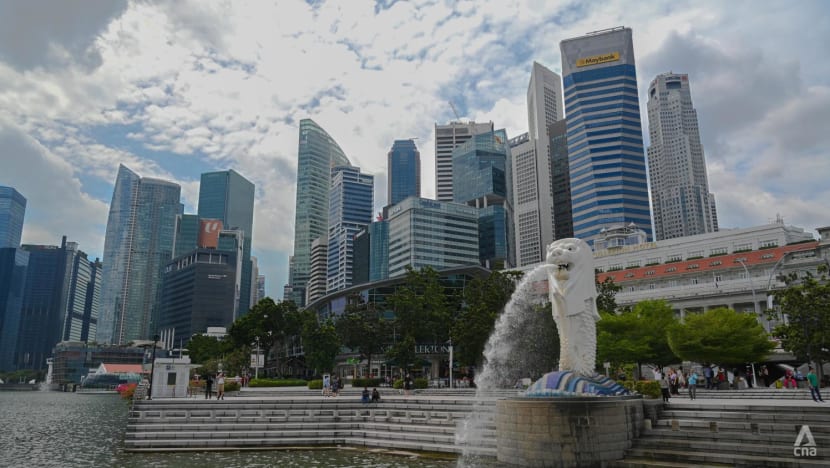Refreshed transformation plan to create 3,800 jobs a year in professional services industry
The updated five-year transformation roadmap also hopes to grow the professional services industry by 3 to 4 per cent each year up till 2025.

A view of Singapore's central business district and the Merlion on Nov 16, 2022. (File photo: CNA/Hanidah Amin)
SINGAPORE: A refreshed five-year blueprint to transform the professional services industry will aim to create 3,800 additional jobs for professionals, managers, executives and technicians (PMETs) each year until 2025.
The new industry transformation map (ITM) also hopes to grow the industry by 3 to 4 per cent each year and reach a value-add of S$27 billion by 2025.
Announcing the launch in Parliament on Tuesday (Feb 28), Minister for Trade and Industry Gan Kim Yong said the updated plan will help to strengthen Singapore’s role as a leading business hub.
“Our professional services sector is well-positioned to seize opportunities for business growth driven by digitalisation, sustainability, emerging markets and new customer segments in Southeast Asia,” he said at his ministry’s Committee of Supply debate.
The professional services industry is made up of company headquarters and a diverse range of firms that provide services ranging from accountancy, advertising, consulting to design.
As part of initiatives under the new ITM, the Economic Development Board (EDB) will continue to work on attracting new companies to set up their global or regional headquarters here, as well as support those that are already based here to transform their corporate functions.
For those with “a clear mandate for new business creation”, EDB will partner these firms to create new ventures that can generate “new revenue pathways outside the parent company’s existing core business”, the government agency said in a separate press release.
To do so, EDB said it will press on with its Corporate Venture Launchpad Programme, which was given an additional S$20 million boost last July to help more companies with innovating new products and services.
The updated ITM will also focus on enhancing the competencies of professional services firms here.
These include helping smaller firms to adopt technology through grants and customised support, developing talent with expertise in growing areas such as sustainability, as well as supporting workers in reskilling and redeployment through schemes like the Career Conversion Programme.
The professional services ITM was first launched in 2018 as one of the 23 sectoral blueprints to drive transformation efforts.
Mr Gan said the ITM sectors have “led the way in terms of economic growth and industry transformation”, although the COVID-19 pandemic “inevitably affected” progress for some.
From 2016 to 2021, these sectors achieved real value-added growth of 2.9 per cent annually – “marginally above” the performance of overall economy at 2.8 per cent a year.
Looking at the years just before the pandemic – that is 2016 to 2019 – the ITM sectors saw real value-added growth of 3.5 per cent a year. This was “a fair bit higher” than the performance of the economy as a whole, which averaged at 3.1 per cent per annum, the minister said.
In terms of productivity, the 23 sectors achieved growth of 4 per cent a year between 2016 and 2021, also outperforming the overall economy's annual productivity growth of 3.5 per cent, said Mr Gan.
Meanwhile, there was a net creation of about 134,000 jobs from 2016 to 2021 despite the pandemic.
Some ITM sectors had performed better than others, such as the financial services sector which exceeded its growth and jobs target. On the other hand, the precision engineering ITM fell short of the job creation target due to the pandemic-induced downturn.
Mr Gan added that authorities have since started refreshing the ITMs to address emerging priorities, such as sustainability, and lessons from the pandemic.
“We should allow some time for these strategies to take root and then assess again the progress of the ITM 2025 strategies,” he told the House.
UPDATES ON 2030 VISION
Ministers also provided an update on the Singapore Economy 2030 vision, which was laid out last year as a long-term “collective vision” for the economy across four key pillars.
Minister of State for Trade and Industry Alvin Tan said “significant progress” has been made in achieving the 2030 vision for manufacturing. First announced in 2021, the goal is to grow the sector’s value-added by 50 per cent from 2020 to 2030.
Last year, the sector saw a more than 15 per cent increase in value-added from 2020, while receiving a record S$17 billion in total fixed asset investment. These projects are expected to create more than 4,600 jobs over the next five years, Mr Tan said.
Authorities have been working with the industry to develop more talents for these new jobs.
For instance, government agencies are working with the trade associations and chambers to offer internship opportunities in the sector for Institute of Technical Education students.
As of September last year, 806 internship opportunities across 71 companies have been created, more than the initial target of securing 200 internships across 50 companies by end-2022, said Mr Tan.
The Government plans to continue growing the manufacturing sector by attracting more “frontier investments” and recruit more locals.
Services is another key pillar, said Mr Tan, adding that the goal by 2030 is to grow the services sector by making firms more digital and sustainable.
The aim also includes anchoring Singapore as a leading hub for businesses, lifestyle and tourism.
The services cluster, which includes outward-oriented sectors such as professional services and domestic-facing ones like retail trade, accounts for around 70 per cent of the country's gross domestic product.


















